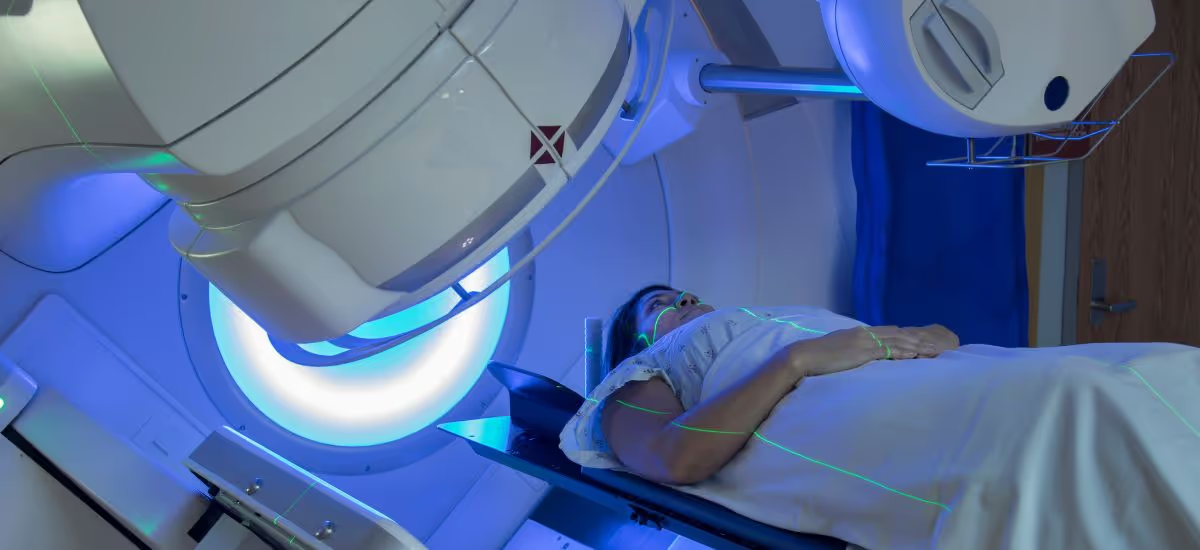What is cancer?
Cancer or malignant tumors are a group of diseases brought on by cell abnormalities in various body organs as a result of a genetic mutation that causes cancerous cells to multiply unlimitedly and grow uncontrollably. Malignant cells grow into cancerous masses that interfere with the organ's normal cell function and spread widely through the bloodstream and lymphatic system to other bodily organs including the lungs, liver, intestines, breast, or lymph nodes. Cancer is classified based on the location of the organ where the disease originated and the type of cancerous cells.
What causes normal cells to become cancerous cells?
In general, the human body produces cells naturally by allowing cells to grow, multiply, and perform their duties depending on where they originated in the body. Typically, a cell's function is determined by its genetic material, or DNA, but when normal cells mutate within the DNA structure, the cells multiply uncontrollably and develop into cancerous cells before gradually expanding into a cancerous mass in the organ of origin. These cancer cells evade the body's natural process of eliminating malignant cells, remain in the body before spreading to other organs and disrupting the body's processes, resulting in a variety of symptoms.
How many groups of cancer?
Cancers are classified based on their properties including cell type, origin, growth, stage, and response to treatment. Cancer that begins in one organ and spreads to other organs retains the same properties as the cancer cell's origin. In other words, cancer that develops in the liver and spreads to the intestines is still liver cancer. Thus, the treatment is primarily focused on the treatment of liver cancer. Cancer can be classified into large groups based on the organ where cancer cells originated, as follows:
- Carcinoma
Carcinomas arise from epithelial cells lining the inside and outside surface of our body. They are common cancers, with names based on their organ of origin.- Adenocarcinoma develops in cells lining the glands producing mucus or fluids. This type of cancer is common in breast, prostate, and colon.
- Basal cell carcinoma is the skin cancer developing in basal layer of the epidermis, the outermost layer of skin.
- Squamous cell carcinomas start in squamous cell layer which are just beneath the outer surface of the skin or in the lining of lungs, esophagus, and bladder.
- Transitional cell carcinoma is formed in transitional epithelium or urothelium found in the linings of the renal pelvis, ureters, and bladder.
- Sarcoma
This type of cancer begins in the bone, fat, muscles, lymph vessels, blood vessels, ligaments, and tendons. The most common bone cancer is osteosarcoma. - Leukemia
Leukemia starts in the bone marrow’s blood-forming tissue. It does not form solid tumors. The abnormal white blood cells crowded out the normal blood cells in the bone marrow, so the body has trouble supplying oxygen to tissues, fighting off infection, and supplying platelets for blood clotting. Leukemia can be classified into many types – acute or chronic and lymphoblastic or myeloid - depending on how fast it progresses and from which blood cell it originates from. - Lymphoma
If the lymphocytes, disease-fighting white blood cells such as T cells or B cells, become abnormal and accumulate in lymph vessels, lymph nodes, or other parts of the body, lymphoma may be developing.
Lymphoma can be categorized into 2 types:- Hodgkin lymphoma is caused by abnormal Reed-Sternberg cells formed from B cells.
- Non-Hodgkin lymphoma begins in lymphocytes and can develop from both the T or B cells.
- Other Types of Tumors
- Melanoma
Melanocytes are specialized cells producing melanin. Melanoma derives from melanocytes; therefore, most melanomas are found in the skin or pigmented tissues of the eyes. - Brain and Spinal Cord Tumors
The name of brain and spinal cord tumors is based on where they are originated and in which type of cells they are formed. For instance, astrocytes are the cells an astrocytic tumor develops from. - Germ Cell Tumors
Germ cell tumors grows from reproductive cells. They can develop almost anywhere in the body and can be benign or malignant. - Neuroendocrine Tumors
Neuroendocrine tumors may be cancerous or non-cancerous. Originating from endocrine cells, they produce higher level of hormones than normal glands causing myriad symptoms. Carcinoid tumors are slow-growing tumors under this category, mostly found in the gastrointestinal tract. Over secretion of serotonin and prostaglandins cause constellation of symptoms called carcinoid syndrome.
- Melanoma
What is the cancer risk factor?
Despite the fact that doctors are still unable to determine whether cancer is caused by a single cause or a combination of causes, cancer risk can be decreased by being aware of and alert to risk factors. Cancer causes and risk factors can be distinguished from external factors such as cigarette smoke, pollution, PM2.5, or carcinogens and internal factors such as genetics as follows:
External factors including:
- Cigarettes and second-hand smoke inhalation are major risk factors for cancer and can lead to serious health issues. Those who smoke or inhale second-hand smoke on a regular basis are at a higher risk of developing cancers such as lung cancer, mouth and throat cancer, laryngeal cancer, esophageal cancer, or cervical cancer.
- Chemicals such as benzene, asbestos, cadmium, nickel, polyvinyl chloride, and pesticides
- Exposure to environmental toxins such as PM2.5, radon gas, uranium, and diesel exhaust, as well as coal products.
- Viruses or bacteria, such as HIV, HPV, and Hepatitis B & C virus.
- Sunlight's ultraviolet (UV) radiation may increase the risk of skin cancer.
- A history of radiation therapy for cancer may increase the risk of recurrence of cancers such as lung cancer, breast cancer, and thyroid cancer.
- Alcohol consumption increases the risk of developing liver cancer, stomach cancer, and colon cancer.
- Excess estrogen hormones are linked to the development of breast cancer and endometrial cancer.
- Carcinogens found in charred, grilled, or fried foods; aflatoxin toxin caused by fungi hydrocarbons; and nitrosamines found in fermented foods.
- High-fat diet may increase the risk of colon cancer, endometrial cancer, and esophageal cancer.
Internal factors including:
- Family cancer Syndromes: This type of cancer is caused by a faulty gene or genetic material.
- Aging: advanced aging may also increase the risk of developing cancer.
What is the sign and symptom of cancer?
Various cancers are asymptomatic in their early stages. Some cancers occur in organs that are difficult to detect or are obscured by other organs in the body, but when cancerous cells spread to other organs, the signs and symptoms of cancer are clearly manifested. If you experience or notice any of the following signs and symptoms, make an early appointment with a medical doctor for a complete diagnosis:
- Abnormal bleeding in areas such as the anus, cervix
- Dysphagia or difficulty swallowing, frequent heartburn
- Chronic fever
- Bloody urine, difficulty urinating
- Black or bloody stools, difficult stools.
- Hoarse voice, chronic cough, cough with bloody sputum
- Body aches, bone pains
- Slow-healing wounds or chronic wounds
- Feel a lump in the neck, breast, or other parts of your body.
- Itches or bleeds a mole, wart, or birthmark on the body.
- Unexplained weight loss.
- Fatigue, loss of appetite
- Abnormal vaginal discharge, bleeding from the vagina
What are the stages of cancer?
The stage is determined by a number of factors, including its size, location, and spread. Basically, the stage of cancer is individual in each type of cancer. Roughly, what are the cancer stage as blow.
- Stage I: Cancer is limited to a small area and has not spread.
- Stage II: Cancer has grown but not spread to lymph nodes or other tissues.
- Stage III: Cancer has grown in size and may have spread to lymph nodes or other tissues.
- Stage IV: Cancer has spread to other organs or parts of the body.
How is cancer diagnosed?
The gold standard of cancer diagnosis is “tissue pathology diagnosis,” which confirms the presence of cancer cells by a pathologist. First, the patient has an area of concern for cancer disease, which is typically detected by X-ray or CT scan (the CT scan has greater precision and accuracy than the regular X-ray).
A tissue biopsy will be performed on the suspected area or mass. The biopsy methods and techniques are varied depending on the tumor location, feasibility, risk, etc. For example, a core needle biopsy is appropriate for a breast mass; bronchoscopy with biopsy is usually performed in lung cancer patients; and sometimes CT guided biopsy is required to provide more precision in the diagnosis.
In some cases, the doctor may incorporate a fluid cytology examination to detect cancer cells while also demonstrating the origin of the tumor, such as sputum cytology, ascites fluid cytology, or pleural fluid cytology.
Currently, the detection of tumor markers such as CEA, CA153, and AFP, which is a primary cancer screening method, is done by drawing blood and cannot substitute for a biopsy for diagnosis. However, tumor markers detection in combination with other cancer detection methods will provide a highly accurate diagnosis.
What is cancer treatment?
Cancer treatment options for cancer vary depending on the location, type, and stage of the disease and the following individual requirements:
- Surgery
Surgery is considered the main treatment option for those with stage I cancer since early detection is the key to a complete recovery. In some cases, chemotherapy or radiation may be advised to shrink the cancer cells before surgery. - Radiation therapy
This approach uses high-powered energy rays to shrink tumors and protons to kill cancer cells. This method is often combined with chemotherapy before or after the surgery. Radiation therapy may be the primary treatment option for patients with metastatic cancer. - Chemotherapy
Chemotherapy uses medications to kill cancer cells. Over a period of weeks or months, chemotherapy medications may be taken orally or applied through the veins in your arm. Furthermore, chemotherapy can be used to kill any remaining cancer cells and alleviate pain after tumor response. - Targeted therapy
Targeted drug therapy focuses on finding abnormalities present within the cancer cells and blocking them, causing these cancer cells to die. The genetic mutation of the cancer cells is studied and tested. This approach is mainly used for patients with metallic cancer. - Immunotherapy
Immunotherapy uses your immune system to interfere with and prevent cancer cells from building proteins. Aim to activate the immune cells to kill cancer cells. - Palliative care and pain management
This form of treatment can also be known as supportive care. This approach involves the patients being in a healthy and strong psychological state after being diagnosed with cancer and receiving treatment. Researchers found that on average, patients with metastatic cancer who received palliative care lived almost 3 months longer than those who received standard treatment.

Annual cancer screening and health checkup
Currently, early-stage of cancer can be cured. However, the exact cause cannot be identified. When cancer cells invade, they destroy surrounding tissues as well as nearby organs and other distant organs. When cancerous cells multiply, those organs will be destroyed until they can't perform their normal functions. Ultimately, the patient will die.
Therefore, the doctor recommends annual cancer screening, particularly for those at high risk who have warning signs and symptoms of cancer. The chances of curing cancer increase when it is accurately diagnosed and systematically treated early.
Related Packages
- Gastroscopy & Colonoscopy Package
- Digital Mammogram with Ultrasound Package
- Thin Prep Test and HPV DNA Package
- Prostate Cancer Screening Package
- Medical CheckUp Programs








